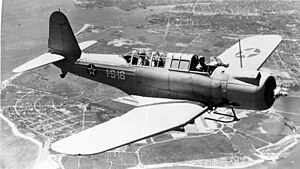SB2U Vindicator
| SB2U Vindicator | |
|---|---|
 |
|
| Role | Dive bomber |
| Manufacturer | Vought |
| First flight | 4 January 1936 |
| Introduction | 1937 |
| Retired | 1945 |
| Primary users |
United States Navy United States Marine Corps French Navy Royal Navy |
| Number built | 260 |
The Vought SB2U Vindicator was a carrier-based dive bomber developed for the United States Navy in the 1930s, the first monoplane in this role. Obsolete at the outbreak of World War II, Vindicators still remained in service at the time of the Battle of Midway, but by 1943, all had been withdrawn to training units. It was known as the Chesapeake in Royal Navy service.
In 1934, the United States Navy issued a requirement for a new Scout Bomber for carrier use, and received proposals from six manufacturers. The specification was issued in two parts, one for a monoplane, and one for a biplane. Vought submitted designs in both categories, which would become the XSB2U-1 and XSB3U-1 respectively. The biplane was considered alongside the monoplane design as a "hedge" against the U.S. Navy's reluctance to pursue the modern configuration.
The XSB2U-1 was of conventional low-wing monoplane configuration with a retractable conventional tailwheel landing gear, the pilot and tail gunner being seated in tandem under a long greenhouse-style canopy. The fuselage was of steel tube construction, covered with aluminum panels from the nose to the rear cockpit with a fabric-covered rear fuselage, while the folding cantilever wing was of all-metal construction. A Pratt & Whitney R-1535 Twin-Wasp Junior radial engine drove a two-blade constant-speed propeller, which was intended to act as a dive brake during a dive bombing attack. A single 1,000 lb (450 kg) bomb could be carried on a swinging trapeze to allow it to clear the propeller in a steep dive, while further bombs could be carried under the wings to give a maximum bombload of 1,500 lb (680 kg).
...
Wikipedia
